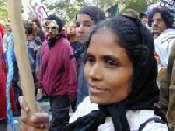
BanglaDesh Woman in Prague

BanglaDesh Woman in Prague |
(held at the Prague Convergence Center, September 2000)
Speakers: Shamsun Nahar Khan Doli of Kisani Sabha (Landless Women's Association) and Badrul Alam of Krishok Federation (Farmers' Federation)
The Landless Women's Association started occupying lands in 1992. It is an independent organisation of women that was formed as a partner organisation to the pre-existing Krishok (Male Peasant) Federation. The first occupations involved 8000 families on four 'chars'. Chars are low-lying islands, formed eg. by deposits in the middle of the river. According to the law, new lands thus formed should be attributed to landless farmers. But the chars have generally been seized by big landowners called jotedars. Direct action has been used to implement the law.
There are now 50 000 families that have thus won access to land. The land occupations have been prepared by the occupation of government buildings (for days at a time), a long intensive sit-in strike and 'gherao'-actions, i.e. the encirclement of government buildings. When the land is occupied, the families organise to defend themselves against the musclemen of the 'jotedars' (landowners) and the local authorities. An alarm system of red flags and whistles is set up (one flag = be on guard; two flags = eat and then come; three flags = drop everything and come!).
It is particularly the women who defend the land because they are always there on the spot, in the chars (while the men fish, look for work or go to the market) and because the musclemen hesitate to kill a woman. The landless women defend themselves with knives, brooms and spears of bamboo. When the men of the jotedars approach in boats, the alarm system is used to gather the women, who try to push the attackers off and stop them from landing.
This tradition of women's self defense has a long history. In the 1940s, shortly before the political independence of India and Pakistan from British rule (i.e. in late 1946-early 1947), tenants were struggling for a larger share of the crop. The movement was called the 'tebhaga' movement, a movement in favour of a two-third share of the harvest for the cultivators. At that time too 'nari bahini', women's troops, were formed, in particular in the most militant phase of the uprising, to defend the tenants' right to their harvests. The jotedars became very nervous!
When Doli is asked why it is the women who are up in front during the battles, she says that the men also participate, but that it is better that the women be in front because women are more oppressed, so they fight harder. And someone has to take care of the children!
Thanks to their unrelenting pressure, the landless managed to make the then military government pass a law in 1897, saying that uncultivated land would be redistributed: 1 acre for each man and 1 for his wife. Recently, the government has tried to reduce this to 1 acre for the man and nothing for the wife. After a long struggle the law was changed, and now assigns 3/4 of an acre to each landless man and woman. But people prefer to squat while paying land taxes all the same, rather than receive (legal) deeds for less than what they consider their rights and less than what they need to survive.
The economic independence of the wife is of great importance since here, as in other parts of South Asia, the husband can repudiate his wife and marry another woman - who will bring a new dowry! As Doli explained, if a man's cow dies it is a financial tragedy. If his wife dies it is an economic opportunity. The Kisani Sabha also wages important struggles against the dowry system of marriage and against the husbands' violence towards women.
They oppose the policies of IMF/WB/WTO. These policies also affect many local issues, for instance the issue of seeds. The storage and selection of seeds is tradionally taken care of by the women and it is an important social role. Through the "Green Revolution", and now genetically modified seeds (GMO), agribusiness companies have tried to break this traditional independence of the farmers. The women of the Kisani Sabha refuse to abandon the traditional system.
The World Bank is using NGOs to try to impose its policies. After the disastrous floods of 1998, big NGOs distributed packages of seeds which were in fact GMOs. The Grameen Bank (often admired in progressive western circles!) reportedly distributed 500 000 packets of GMO seeds. To make things worse, a lot of it turned out to be sterile.
Conclusions concerning strategy:
The Kisani Sabha's strategy combines direct action and legal means. They consider that they have the right to self defense, even violent if necessary. But their violence is always done 'with cool hands', that is to say with restraint, without losing control. Their violence is considered legitimate in BanglaDesh.
There have been some cases of courts accusing their leaders of violence. 'But all the dead are usually squatters.' In August an attack on char Hadi (one of the chars occupied in 1992) resulted in the death of a leader of the Krishok Federation and 10 women and men were wounded and had to be hospitalised. What are the limits to this strategy? "We don't compromise. That is a peasant tradition. We will continue as long as necessary. There is an enormous amount of fallow land in Bangladesh..."
The struggle has brought the women out of the house, and has broken the traditional division of labor between women and men.
Notes by OdM
The struggle continues!